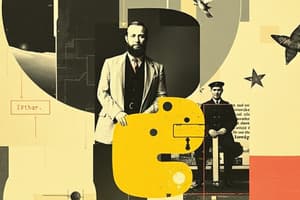Podcast
Questions and Answers
What is the primary focus of Python's design philosophy?
What is the primary focus of Python's design philosophy?
- Code readability (correct)
- Code complexity
- Execution speed
- Memory efficiency
What type of programming language is Python?
What type of programming language is Python?
- Functional programming only
- Object-oriented only
- Dynamically typed (correct)
- Statically typed
What is a notable feature of Python's standard library?
What is a notable feature of Python's standard library?
- It is minimalistic
- It is only suitable for machine learning
- It is only compatible with Python 3.x
- It is comprehensive (correct)
Who was the lead developer of Python until 2018?
Who was the lead developer of Python until 2018?
What was the significance of Python 3.0, released in 2008?
What was the significance of Python 3.0, released in 2008?
What was the initial end-of-life date for Python 2.7?
What was the initial end-of-life date for Python 2.7?
Which Python version added the | union type operator and the match and case keywords?
Which Python version added the | union type operator and the match and case keywords?
What is the current status of Python 2.7 and older versions?
What is the current status of Python 2.7 and older versions?
What was the reason for the expedited security updates in 2021 and 2022?
What was the reason for the expedited security updates in 2021 and 2022?
What is the latest stable release of Python as of October 2023?
What is the latest stable release of Python as of October 2023?
Flashcards are hidden until you start studying
Study Notes
General-Purpose Programming Language
- Python is a high-level, general-purpose programming language that emphasizes code readability using significant indentation.
Design and Features
- Python is dynamically typed and garbage-collected.
- Supports multiple programming paradigms: structured, object-oriented, and functional programming.
- Often described as a "batteries included" language due to its comprehensive standard library.
History
- Invented in the late 1980s by Guido van Rossum as a successor to the ABC programming language.
- Guido van Rossum was the lead developer and "benevolent dictator for life" (BDFL) until 2018.
- In 2019, a five-member Steering Council was elected to lead the project.
Releases
- Python 2.0 was released in 2000 with features like list comprehensions and Unicode support.
- Python 3.0 was released in 2008 with many backported features to Python 2.6.x and 2.7.x.
- Python 2.7.18 was the last release of Python 2 in 2020.
- Python 3.8 and later are currently supported (as of 2023).
- Python 3.9 series and older will only receive security fixes.
Security Updates
- In 2021 and 2022, security updates were expedited due to security issues leading to remote code execution and web-cache poisoning.
- Releases 3.10.4, 3.9.12, and 3.8.13 were expedited due to many security issues.
- Releases 3.10.7, 3.9.14, 3.8.14, and 3.7.14 were made due to a potential denial-of-service attack.
Notable Changes
- Python 3.11 added increased program execution speed, improved error reporting, and expanded exception handling functionality.
- Python 3.10 added the | union type operator and match and case keywords for structural pattern matching statements.
- Python 3.12 added the new keyword type.
Studying That Suits You
Use AI to generate personalized quizzes and flashcards to suit your learning preferences.




